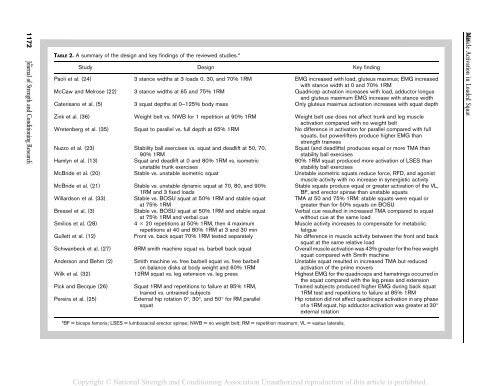muscle-activation-in-the-loaded-free-barbell-squat-a-brief-review
muscle-activation-in-the-loaded-free-barbell-squat-a-brief-review
muscle-activation-in-the-loaded-free-barbell-squat-a-brief-review
You also want an ePaper? Increase the reach of your titles
YUMPU automatically turns print PDFs into web optimized ePapers that Google loves.
Copyright © National Strength and Condition<strong>in</strong>g Association Unauthorized reproduction of this article is prohibited.<br />
1172 Journal of Strength and Condition<strong>in</strong>g Research<br />
<strong>the</strong><br />
TM<br />
TABLE 2. A summary of <strong>the</strong> design and key f<strong>in</strong>d<strong>in</strong>gs of <strong>the</strong> <strong>review</strong>ed studies.*<br />
Study Design Key f<strong>in</strong>d<strong>in</strong>g<br />
Paoli et al. (24) 3 stance widths at 3 loads 0, 30, and 70% 1RM EMG <strong>in</strong>creased with load, gluteus maximus; EMG <strong>in</strong>creased<br />
with stance width at 0 and 70% 1RM<br />
McCaw and Melrose (22) 3 stance widths at 65 and 75% 1RM Quadricep actvation <strong>in</strong>creases with load, adductor longus<br />
and gluteus maximum EMG <strong>in</strong>crease with stance width<br />
Caterisano et al. (5) 3 <strong>squat</strong> depths at 0–125% body mass Only gluteus maximus <strong>activation</strong> <strong>in</strong>creases with <strong>squat</strong> depth<br />
Z<strong>in</strong>k et al. (36) Weight belt vs. NWB for 1 repetition at 90% 1RM Weight belt use does not affect trunk and leg <strong>muscle</strong><br />
<strong>activation</strong> compared with no weight belt<br />
Wretenberg et al. (35) Squat to parallel vs. full depth at 65% 1RM No difference <strong>in</strong> <strong>activation</strong> for parallel compared with full<br />
<strong>squat</strong>s, but powerlifters produce higher EMG than<br />
strength tra<strong>in</strong>ees<br />
Nuzzo et al. (23) Stability ball exercises vs. <strong>squat</strong> and deadlift at 50, 70,<br />
90% 1RM<br />
Squat (and deadlifts) produces equal or more TMA than<br />
stability ball exercises<br />
Hamlyn et al. (13)<br />
Squat and deadlift at 0 and 80% 1RM vs. isometric<br />
unstable trunk exercises<br />
80% 1RM <strong>squat</strong> produced more <strong>activation</strong> of LSES than<br />
stability ball exercises<br />
McBride et al. (20) Stable vs. unstable isometric <strong>squat</strong> Unstable isometric <strong>squat</strong>s reduce force, RFD, and agonist<br />
<strong>muscle</strong> activity with no <strong>in</strong>crease <strong>in</strong> synergistic activity<br />
McBride et al. (21) Stable vs. unstable dynamic <strong>squat</strong> at 70, 80, and 90%<br />
1RM and 3 fixed loads<br />
Stable <strong>squat</strong>s produce equal or greater <strong>activation</strong> of <strong>the</strong> VL,<br />
BF, and erector sp<strong>in</strong>ae than unstable <strong>squat</strong>s<br />
Willardson et al. (33)<br />
Stable vs. BOSU <strong>squat</strong> at 50% 1RM and stable <strong>squat</strong><br />
at 75% 1RM<br />
TMA at 50 and 75% 1RM: stable <strong>squat</strong>s were equal or<br />
greater than for 50% <strong>squat</strong>s on BOSU<br />
Bressel et al. (3)<br />
Stable vs. BOSU <strong>squat</strong> at 50% 1RM and stable <strong>squat</strong><br />
at 75% 1RM and verbal cue<br />
Verbal cue resulted <strong>in</strong> <strong>in</strong>creased TMA compared to <strong>squat</strong><br />
without cue at <strong>the</strong> same load<br />
Smilios et al. (28)<br />
4 3 20 repetitions at 50% 1RM, <strong>the</strong>n 4 maximum<br />
repetitions at 40 and 80% 1RM at 3 and 30 m<strong>in</strong><br />
Muscle activity <strong>in</strong>creases to compensate for metabolic<br />
fatigue<br />
Gullett et al. (12) Front vs. back <strong>squat</strong> 70% 1RM tested separately No difference <strong>in</strong> <strong>muscle</strong> activity between <strong>the</strong> front and back<br />
<strong>squat</strong> at <strong>the</strong> same relative load<br />
Schwanbeck et al. (27) 8RM smith mach<strong>in</strong>e <strong>squat</strong> vs. <strong>barbell</strong> back <strong>squat</strong> Overall <strong>muscle</strong> <strong>activation</strong> was 43% greater for <strong>the</strong> <strong>free</strong> weight<br />
<strong>squat</strong> compared with Smith mach<strong>in</strong>e<br />
Anderson and Behm (2) Smith mach<strong>in</strong>e vs. <strong>free</strong> <strong>barbell</strong> <strong>squat</strong> vs. <strong>free</strong> <strong>barbell</strong><br />
on balance disks at body weight and 60% 1RM<br />
Unstable <strong>squat</strong> resulted <strong>in</strong> <strong>in</strong>creased TMA but reduced<br />
<strong>activation</strong> of <strong>the</strong> prime movers<br />
Wilk et al. (32) 12RM <strong>squat</strong> vs. leg extension vs. leg press Highest EMG for <strong>the</strong> quadriceps and hamstr<strong>in</strong>gs occurred <strong>in</strong><br />
<strong>the</strong> <strong>squat</strong> compared with <strong>the</strong> leg press and extension<br />
Pick and Becque (26) Squat 1RM and repetitions to failure at 85% 1RM,<br />
tra<strong>in</strong>ed vs. untra<strong>in</strong>ed subjects<br />
Tra<strong>in</strong>ed subjects produced higher EMG dur<strong>in</strong>g back <strong>squat</strong><br />
1RM test and repetitions to failure at 85% 1RM<br />
Pereira et al. (25)<br />
External hip rotation 0°, 30°, and 50° for RM parallel<br />
<strong>squat</strong><br />
Hip rotation did not affect quadriceps <strong>activation</strong> <strong>in</strong> any phase<br />
of a 1RM <strong>squat</strong>, hip adductor <strong>activation</strong> was greater at 30°<br />
external rotation<br />
*BF = biceps femoris; LSES = lumbosacral erector sp<strong>in</strong>ae; NWB = no weight belt; RM = repetition maximum; VL = vastus lateralis.<br />
Muscle AU1 Activation <strong>in</strong> Loaded Squat


